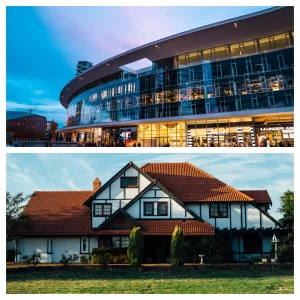What is the Difference Between Residential and Commercial Building?
Introduction
What is the difference between residential and commercial building? Construction of buildings has always been an essential component of human civilisation, playing an important role in the development of how people live, work, and interact with their surroundings. Buildings can be found in a wide variety of forms and dimensions; they fulfil a wide range of functions and satisfy a variety of requirements. However, not all structures were designed and constructed in the same manner, and it is essential for those working in architecture, engineering, construction, and real estate to be aware of the differences between them.

In this post, we will examine the primary distinctions between residential and commercial structures, as well as the fundamentals of their design and construction, as well as the specific issues that each type of building presents.
Residential Buildings
Houses, apartments, condominiums, and townhouses are all examples of residential buildings because they are designed and constructed with the intention of housing people. The local culture, climate, and building codes all play a role in determining the size, design, and architectural characteristics of these buildings. On the other hand, they all have some qualities in common with one another that set them apart from commercial structures.
Use and Function
For individuals or families, having a safe place to live and adequate space to do so is the most important thing that a residential building can do for them. It consists of a variety of rooms such as bedrooms, bathrooms, kitchens, and living areas, in addition to storage places, garages, and outside areas. Whether the inhabitants are single people, couples, or families with children, residential buildings are constructed to meet the requirements and preferences of the people who will be living there. They typically provide a sense of seclusion, safety, and comfort, and can be found in towns or neighbourhoods that are predominantly residential.
Design and Construction
Residential building rules, which control the safety, accessibility, and environmental effect of residential buildings, are followed in both the design and construction of residential buildings. In most cases, they feature an uncomplicated and uncomplicated design, which often includes a pitched roof, symmetrical front, and minimum adornment. Residential structures are often framed with wood or concrete, clad in brick, stone, or stucco, and equipped with insulation, heating and cooling, plumbing, and electrical systems that conform to industry standards.
Challenges and Considerations
Architects and builders are required to take into account a one-of-a-kind set of obstacles and issues that are specific to residential constructions. For instance, they should be built to survive natural disasters like earthquakes, hurricanes, or floods, and they should also be designed to minimise the amount of noise, pollution, and other negative effects on the environment. Zoning and land-use regulations may place restrictions on the height, density, or setback requirements of residential buildings, and these regulations must be complied with as well.
Commercial Buildings
Buildings that are designed and constructed specifically for use in commercial or business activities are known as commercial buildings. Examples of commercial buildings include places of business, retail stores, restaurants, hotels, and storage facilities. In comparison to residential structures, commercial structures are typically larger and more complicated, necessitating a distinct methodology for their design and construction.
Use and Function
A commercial building’s principal purpose is to provide space for commercial activities, such as business operations, sales, marketing, storage, or distribution. This can also be one of the building’s secondary functions. Open floor plans, customer service spaces, and specialised equipment are some of the features that are commonly included in the design of commercial buildings in order to fulfil the requirements of the tenants. They are typically found in business or industrial zones, which are characterised by considerable traffic and provide many opportunities to interact with prospective clients.

Design and Construction
Commercial building codes, which control the safety, accessibility, and environmental effect of commercial buildings, are adhered to during the design and construction of commercial structures. They call for a layout that is more intricate and specialised, with elements such as high ceilings, wide windows, loading docks, elevators, and fire suppression systems, among other things. Typically, the framework of commercial buildings is made of concrete or steel, and the exterior is wrapped in glass or metal. Additionally, these structures have highly developed insulation, plumbing, electrical, and HVAC systems.
Challenges and Considerations
When designing and constructing commercial buildings, architects and construction workers are faced with a one-of-a-kind set of obstacles and considerations. For instance, they need to be built in a way that takes into account the particular requirements of the company, such as its branding, marketing, and advertising strategies. Additionally, they have to ensure that they are in compliance with zoning and land-use regulations, which may place restrictions on the kinds of commercial operations that are permitted in a certain region. In addition, in order to keep up with the ever-shifting requirements of the business and to ensure that the building complies with all applicable safety and environmental standards, regular maintenance and upgrades of commercial buildings are required. https://citibuildconstruction.com.au/
Conclusion
In a nutshell, residential and commercial buildings are two distinct categories of structures, each of which is designed to fulfil a unique function and is built according to an entirely different set of guiding principles. Buildings that will be inhabited by people are referred to as residential buildings, whereas buildings that will be used for commercial or business reasons are referred to as commercial buildings. In order to ensure the functionality, safety, and long-term viability of the built environment, experts in the fields of architecture, engineering, construction, and real estate must be familiar with the specific problems and factors that are presented by the many types of buildings.
Demand for residential and commercial buildings is expected to continue rising in tandem with the expansion and development of our cities in the coming years. By gaining an awareness of the distinctions between them, we will be able to design and construct structures that are superior, more energy-efficient, and more liveable, thereby catering to the requirements and goals of the communities we serve.
